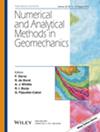有限汉克尔变换局部透水桩加固非饱和土复合地基半解析解
IF 3.6
2区 工程技术
Q2 ENGINEERING, GEOLOGICAL
International Journal for Numerical and Analytical Methods in Geomechanics
Pub Date : 2025-06-12
DOI:10.1002/nag.70000
引用次数: 0
摘要
带孔管桩等半透水柱的应用,为复合地基中桩型的选择提供了新的思路。在自由应变假设下,引入柱土界面参数,建立了局部透水桩非饱和土复合地基轴对称固结模型。通过应用拉普拉斯变换、有限汉克尔变换和它们的逆变换,得到了考虑径向流和垂直流的半解析解。通过将所提出的解决方案与现有文献中的控制方程和半解析解进行比较,验证了其有效性。此外,还研究了不同影响因素对含半渗透柱的超细混凝土固结性能的影响。结果表明:增大柱土界面参数和面积置换比,加速了超孔隙压力的消散,从而缩短了超孔隙压力完全消散所需的时间;值得注意的是,当柱土界面参数超过10时,其对超孔压耗散加速度的影响可以忽略不计。本文章由计算机程序翻译,如有差异,请以英文原文为准。
Semi‐Analytical Solution for Consolidation of Unsaturated Soil Composite Foundation Improved by Local Permeable Pile With Finite Hankel Transform
The application of semi‐permeable columns, such as the pipe pile with holes, provides new insights for the selection of pile types in composite foundations. In this study, the axisymmetric consolidation model of unsaturated soil composite foundation (USCF) with local permeable pile by introducing the column‐soil interface parameters is established under the free‐strain assumption. By applying Laplace transforms, finite Hankel transforms, and their inverse transforms, a semi‐analytical solution is obtained, accounting for both radial and vertical flow. The effectiveness of the presented solution is verified by comparing it with governing equations and semi‐analytical solutions from existing literature. Furthermore, the consolidation behaviors of USCF with semi‐permeable columns are studied under various influencing factors. The results indicate that an increase in the column‐soil interface parameter and area replacement ratio accelerated the dissipation of excess pore pressures, thus shortening the time required for its complete dissipation. It is noteworthy that when the column‐soil interface parameter exceeds 10, its effect on the acceleration of excess pore pressure dissipation becomes negligible.
求助全文
通过发布文献求助,成功后即可免费获取论文全文。
去求助
来源期刊
CiteScore
6.40
自引率
12.50%
发文量
160
审稿时长
9 months
期刊介绍:
The journal welcomes manuscripts that substantially contribute to the understanding of the complex mechanical behaviour of geomaterials (soils, rocks, concrete, ice, snow, and powders), through innovative experimental techniques, and/or through the development of novel numerical or hybrid experimental/numerical modelling concepts in geomechanics. Topics of interest include instabilities and localization, interface and surface phenomena, fracture and failure, multi-physics and other time-dependent phenomena, micromechanics and multi-scale methods, and inverse analysis and stochastic methods. Papers related to energy and environmental issues are particularly welcome. The illustration of the proposed methods and techniques to engineering problems is encouraged. However, manuscripts dealing with applications of existing methods, or proposing incremental improvements to existing methods – in particular marginal extensions of existing analytical solutions or numerical methods – will not be considered for review.

 求助内容:
求助内容: 应助结果提醒方式:
应助结果提醒方式:


